Predictable t-SNE#
Links: notebook, html, PDF, python, slides, GitHub
t-SNE is not a transformer which can produce outputs for other inputs than the one used to train the transform. The proposed solution is train a predictor afterwards to try to use the results on some other inputs the model never saw.
from jyquickhelper import add_notebook_menu
add_notebook_menu()
%matplotlib inline
t-SNE on MNIST#
Let’s reuse some part of the example of Manifold learning on handwritten digits: Locally Linear Embedding, Isomap….
import numpy
from sklearn import datasets
digits = datasets.load_digits(n_class=6)
Xd = digits.data
yd = digits.target
imgs = digits.images
n_samples, n_features = Xd.shape
n_samples, n_features
(1083, 64)
Let’s split into train and test.
from sklearn.model_selection import train_test_split
X_train, X_test, y_train, y_test, imgs_train, imgs_test = train_test_split(Xd, yd, imgs)
from sklearn.manifold import TSNE
tsne = TSNE(n_components=2, init='pca', random_state=0)
X_train_tsne = tsne.fit_transform(X_train, y_train)
X_train_tsne.shape
(812, 2)
import matplotlib.pyplot as plt
from matplotlib import offsetbox
def plot_embedding(Xp, y, imgs, title=None, figsize=(12, 4)):
x_min, x_max = numpy.min(Xp, 0), numpy.max(Xp, 0)
X = (Xp - x_min) / (x_max - x_min)
fig, ax = plt.subplots(1, 2, figsize=figsize)
for i in range(X.shape[0]):
ax[0].text(X[i, 0], X[i, 1], str(y[i]),
color=plt.cm.Set1(y[i] / 10.),
fontdict={'weight': 'bold', 'size': 9})
if hasattr(offsetbox, 'AnnotationBbox'):
# only print thumbnails with matplotlib > 1.0
shown_images = numpy.array([[1., 1.]]) # just something big
for i in range(X.shape[0]):
dist = numpy.sum((X[i] - shown_images) ** 2, 1)
if numpy.min(dist) < 4e-3:
# don't show points that are too close
continue
shown_images = numpy.r_[shown_images, [X[i]]]
imagebox = offsetbox.AnnotationBbox(
offsetbox.OffsetImage(imgs[i], cmap=plt.cm.gray_r),
X[i])
ax[0].add_artist(imagebox)
ax[0].set_xticks([]), ax[0].set_yticks([])
ax[1].plot(Xp[:, 0], Xp[:, 1], '.')
if title is not None:
ax[0].set_title(title)
return ax
plot_embedding(X_train_tsne, y_train, imgs_train, "t-SNE embedding of the digits");
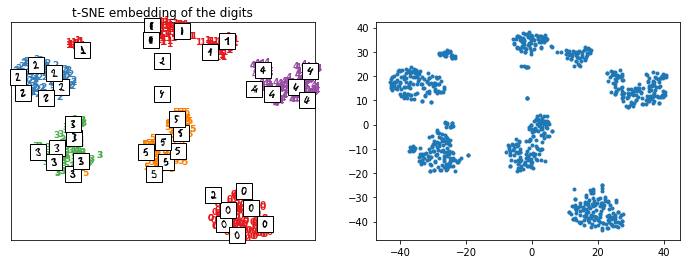
Repeatable t-SNE#
We use class PredictableTSNE but it works for other trainable transform too.
from mlinsights.mlmodel import PredictableTSNE
ptsne = PredictableTSNE()
ptsne.fit(X_train, y_train)
c:python370_x64libsite-packagessklearnneural_networkmultilayer_perceptron.py:562: ConvergenceWarning: Stochastic Optimizer: Maximum iterations (200) reached and the optimization hasn't converged yet. % self.max_iter, ConvergenceWarning)
PredictableTSNE(e_activation='relu', e_alpha=0.0001, e_batch_size='auto',
e_beta_1=0.9, e_beta_2=0.999, e_early_stopping=False,
e_epsilon=1e-08, e_hidden_layer_sizes=(100,),
e_learning_rate='constant', e_learning_rate_init=0.001,
e_max_iter=200, e_momentum=0.9, e_n_iter_no_change=10,
e_nesterovs_momentum=True, e_power_t=0.5, e_random_state=None,
e_shuffle=True, e_solver='adam', e_tol=0.0001,
e_validation_fraction=0.1, e_verbose=False, e_warm_start=False,
t_angle=0.5, t_early_exaggeration=12.0, t_init='random',
t_learning_rate=200.0, t_method='barnes_hut', t_metric='euclidean',
t_min_grad_norm=1e-07, t_n_components=2, t_n_iter=1000,
t_n_iter_without_progress=300, t_perplexity=30.0,
t_random_state=None, t_verbose=0)
X_train_tsne2 = ptsne.transform(X_train)
plot_embedding(X_train_tsne2, y_train, imgs_train, "Predictable t-SNE of the digits");
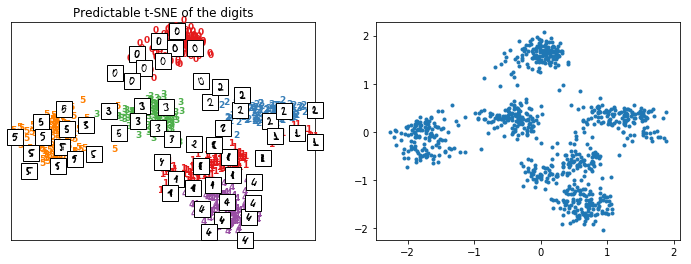
The difference now is that it can be applied on new data.
X_test_tsne2 = ptsne.transform(X_test)
plot_embedding(X_test_tsne2, y_test, imgs_test, "Predictable t-SNE on new digits on test database");
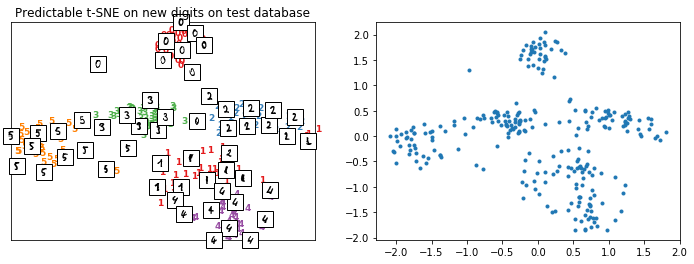
By default, the output data is normalized to get comparable results over multiple tries such as the loss computed between the normalized output of t-SNE and their approximation.
ptsne.loss_
0.024681568435970355
Repeatable t-SNE with another predictor#
The predictor is a MLPRegressor.
ptsne.estimator_
MLPRegressor(activation='relu', alpha=0.0001, batch_size='auto', beta_1=0.9,
beta_2=0.999, early_stopping=False, epsilon=1e-08,
hidden_layer_sizes=(100,), learning_rate='constant',
learning_rate_init=0.001, max_iter=200, momentum=0.9,
n_iter_no_change=10, nesterovs_momentum=True, power_t=0.5,
random_state=None, shuffle=True, solver='adam', tol=0.0001,
validation_fraction=0.1, verbose=False, warm_start=False)
Let’s replace it with a KNeighborsRegressor and a normalizer StandardScaler.
from sklearn.neighbors import KNeighborsRegressor
from sklearn.preprocessing import StandardScaler
ptsne_knn = PredictableTSNE(normalizer=StandardScaler(),
estimator=KNeighborsRegressor())
ptsne_knn.fit(X_train, y_train)
PredictableTSNE(e_algorithm='auto', e_leaf_size=30, e_metric='minkowski',
e_metric_params=None, e_n_jobs=None, e_n_neighbors=5, e_p=2,
e_weights='uniform', n_copy=True, n_with_mean=True,
n_with_std=True, t_angle=0.5, t_early_exaggeration=12.0,
t_init='random', t_learning_rate=200.0, t_method='barnes_hut',
t_metric='euclidean', t_min_grad_norm=1e-07, t_n_components=2,
t_n_iter=1000, t_n_iter_without_progress=300, t_perplexity=30.0,
t_random_state=None, t_verbose=0)
X_train_tsne2 = ptsne_knn.transform(X_train)
plot_embedding(X_train_tsne2, y_train, imgs_train,
"Predictable t-SNE of the digits\nStandardScaler+KNeighborsRegressor");
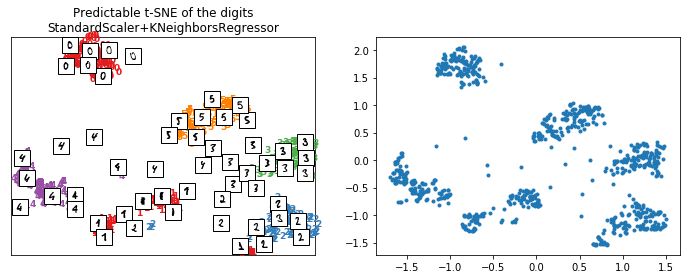
X_test_tsne2 = ptsne_knn.transform(X_test)
plot_embedding(X_test_tsne2, y_test, imgs_test,
"Predictable t-SNE on new digits\nStandardScaler+KNeighborsRegressor");
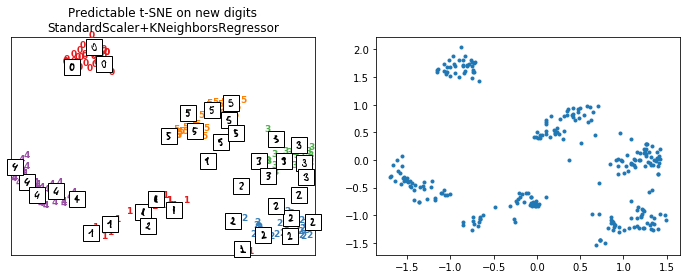
The model seems to work better as the loss is better but as it is evaluated on the training dataset, it is just a way to check it is not too big.
ptsne_knn.loss_
0.004112159